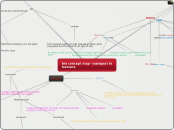bio concept map- transport in humans
HEART
right
atrium
triscupid valves
receive deoxygenated blood from vena cava and pump into right ventricle
ventricle
less muscular, pump deoxygenated blood to lungs
left
atrium
biscupid valves
receive oxygenated blood from pulmonary vein and pump into left ventrivle
ventricle
most muscular, excert very high pressure on blood, pump oxygenated blood from heart to all parts of body
septum
prevent mixing og oxygenatedand deoxygenated blood
BLOOD
red blood cell
has haemoglobin
iron containing protein complex found in red blood cells which has high affinity for oxygen; carries oxygen
biconcave shape
increased surface area for absorption of oxygen
no nucleus
increased volume for absorption of oxygen
thin flexible membrane
enable bending through narrow capillaries
acclimatisation occurs when body produces more red blood cells which contains haemoglobin to carry more oxygen so as to compensate for the lower concentration of oxygen breathed into the body with each breath
white blood cell
leucocytes
colourless, irregular in shape, able to squeeze through pores in capillary wall to reach site of infection, has nucleus
to protect the body against infections and diseases
lymphocyte
produced by lymph nodes, round nucleus non granular cytoplasm, produces antibodies during invasion by foreign particles
neutralise toxins
attach and bind to the foreign bodies
agglutination of foreign bodies
becomes memory cells that can recognise same invaders
administering weekend or deadpathogens to healthy person
immune system reacts to the pathogen by producing antibodies against it
body becomes immune
phagocyte
produces by bone marrow, lobed nucleus, granular/ non granular cytoplasm, engulfs and digest bacteria in process called phagocytosis
platelets
prevent excessive blood loss by causing clotting to occur
cytoplasmic fragments of a large cell (megakaryocyte) produced by the bone marrow
Irregularly shaped
no nucleus
plasma
nutrients, carbon dioxide, waste products (e.g. urea) produced by body cells are transported through the body in the plasma
BLOOD VESSELS
Arteries
Thick walls
to withstand high pressure of blood flowing through from heart
elasticity enables walll to stretch and recoil
Carries oxygenated blood (except pulmonatory artery)
Carries blood from heart to organsundefined
No valves
Veins
Thin walls
blood pressure in the veins is much lower than in arteries
stretchable
Carries deoxydenated blood (except pulmonary vein)
Carries blood from organs to lungsundefined
Have valves
ensures blood flows in one direction, preventing backflow of blood
Capillaries
Single-layer of cells
No valves
the exchange of gases, nutrients and metabolic waste products takes place through capillary walls by diffusion.
thin walls that are only one cell-thick allow gases to move through to body tissues easily and at a fast rate
